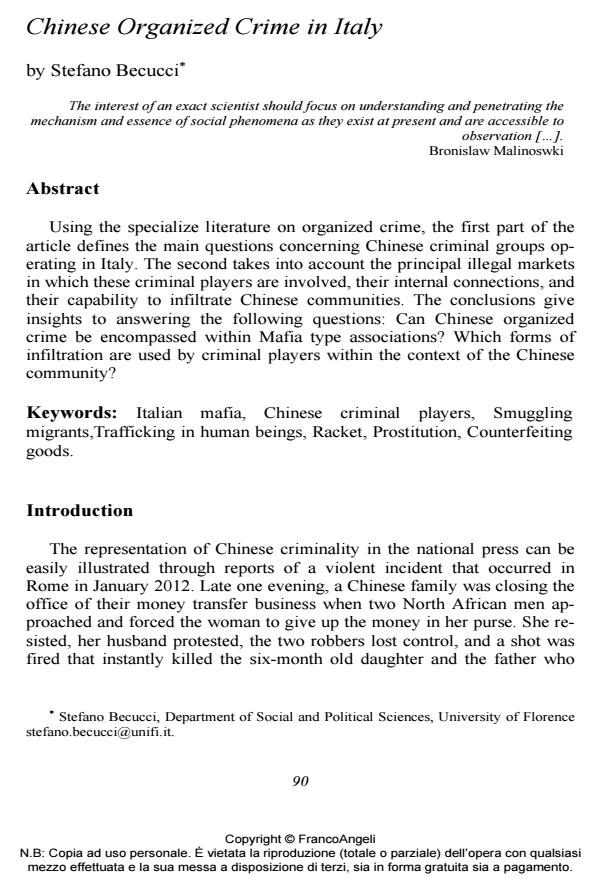Chinese Organized Crime in Italy
Titolo Rivista SICUREZZA E SCIENZE SOCIALI
Autori/Curatori Stefano Becucci
Anno di pubblicazione 2014 Fascicolo 2013/3EN Lingua Inglese
Numero pagine 21 P. 90-110 Dimensione file 637 KB
DOI 10.3280/SISS2013-003007EN
Il DOI è il codice a barre della proprietà intellettuale: per saperne di più
clicca qui
Qui sotto puoi vedere in anteprima la prima pagina di questo articolo.
Se questo articolo ti interessa, lo puoi acquistare (e scaricare in formato pdf) seguendo le facili indicazioni per acquistare il download credit. Acquista Download Credits per scaricare questo Articolo in formato PDF

FrancoAngeli è membro della Publishers International Linking Association, Inc (PILA)associazione indipendente e non profit per facilitare (attraverso i servizi tecnologici implementati da CrossRef.org) l’accesso degli studiosi ai contenuti digitali nelle pubblicazioni professionali e scientifiche
Using the specialize literature on organized crime, the first part of the article defines the main questions concerning Chinese criminal groups operating in Italy. The second takes into account the principal illegal markets in which these criminal players are involved, their internal connections, and their capability to infiltrate Chinese communities. The conclusions give insights to answering the following questions: Can Chinese organized crime be encompassed within Mafia type associations? Which forms of infiltration are used by criminal players within the context of the Chinese community?
Keywords:Italian mafia, Chinese criminal players, Smuggling migrants,Trafficking in human beings, Racket, Prostitution, Counterfeiting goods.
- Maltz D. M. (1976), On Defining “Organized Crime”, Crime & Delinquency, July, pp. 338-346.
- Albini J. (1971), The American Mafia. Genesis of a legend, New York: Appleton Century Crofts.
- Arlacchi P. (1983), La mafia imprenditrice. L’etica mafiosa e lo spirito del capitalismo, Bologna: Il Mulino.
- Arlacchi P. (1992), Gli uomini del disonore, Milano: Mondadori.
- Brodeur J.P. (1997), Organized crime. Trends in the literature, International Annals of Criminology, vol. 35, 1-2, pp. 89-129. Block A. (1974), The Mafia of a Sicilian Village, 1860-1960: A Study of Violent Peasant Entrepreneurs, New York: Harper & Row.
- Catanzaro R. (1991), Il delitto come impresa. Storia sociale della mafia, Rizzoli: Milan.
- Chin Ko-lin (1995), Chinatown Gangs. Extortion, Enterprise and, Ethnicity, New York-Oxford: Oxford University Press.
- Chin Ko-lin, Godson R. (2006), Organized Crime and the Political-Criminal Nexus in China, Trends in Organized Crime, Vol. 9, 3, pp. 5-44.
- Ciconte E. (2010), La criminalità straniera in Toscana, Regione Toscana-Avviso Pubblico, (available at www.regionetoscana.it/documents/10180/23718, accessed 18 May 2010).
- Cohen A. (1977), The Concept of Criminal Organization, The British Journal of Criminology, 17, 2, pp. 97-11.
- Direzione Investigativa Antimafia (DIA) (2008), Attività svolta e risultati conseguiti (I semestre), Rome: Ministero dell’Interno.
- European Union (EU) (2009), IRP Enforcement Report 2009, Brussels: Commission of the European Communities.
- Gambetta D. (1996), The Sicilian Mafia. The business of private protection, Harvard: Harvard University Press.
- Gratteri N., Nicaso A. (2010), La mala pianta, Milan: Mondadori.
- Hagan E. F. (1982), The organized crime continuum: A further specification of a new conceptual model, (paper presented at the annual meeting of the Academy of Criminal Justice Sciences, Louisville, Ky., March, pp. 52-57).
- Lupo S. (1996), Storia della mafia dalle origini ai giorni nostri, Rome: Donzelli. Malinowski B. (1993)[1913], Totemism and exogamy, in R.J. Thornton, P. Skalnik eds, The early writings of Bronislaw Malinoswki, Cambridge: Cambridge University Press, pp. 123-200.
- Marsden A. (1997), Le comunità cinesi viste dalla stampa: informazioni e stereotipi, in A. Ceccagno ed., Il caso delle comunità cinesi. Comunicazione interculturale ed istituzioni, Rome: Armando, pp. 207-222.
- Mirante E. (2008), “Chinatown” e “mafia gialla”: la comunità dell’Esquilino nella cronaca romana, in V. Pedone ed., Il vicino cinese. La comunità cinese di Roma, Rome: Nuove Edizioni Romane, pp. 73-86.
- Napoleoni L. (2009[2008]), Economia canaglia. Il lato oscuro del nuovo ordine mondiale, Milan: Il Saggiatore.
- Paoli L. (2003), Mafia Brotherhoods, New York: Oxford University Press.
- Ping H. (2006), Is Money laundering a True Problem in China?, International Journal Offender Therapy and Comparative Criminology, Vol. 50, 1, pp. 101-116.
- Savona E. U. (2010), Le organizzazioni criminali in Europa viste dall’esperienza italiana, in G. Fiandaca, C. Visconti eds, Scenari di mafia. Orizzonte criminologico e innovazioni normative, Turin: Giappichelli Editore, pp. 29-37.
- Sellin T. (1963), Organized Crime: A Business Enterprise, The Annals of the American Academy, 347, pp. 12-19.
- USA, Office of the United States Trade Representative (2010), 2010 Special 301 Report, United States Trade Representative, 30 April.
- Wang J.Z. (2001), Illegal Chinese Immigration into the United States: A Preliminary Factor Analysis, International Journal Offender Therapy and Comparative Criminology, 45, pp. 345-355.
- Xia M. (2008), Organizational Formations of Organized Crime in China: perspectives from the state, markets, and network, Journal of Contemporary China, 54, 17, pp. 1-23.
Stefano Becucci, Chinese Organized Crime in Italy in "SICUREZZA E SCIENZE SOCIALI" 3EN/2013, pp 90-110, DOI: 10.3280/SISS2013-003007EN